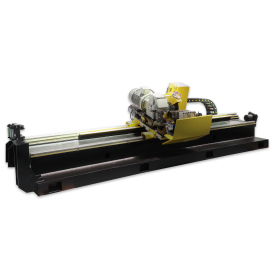[Precision Flying Saw Machine]Revolutionizing Manufacturing Efficiency: The Unmatched Precision of the Precision Flying Saw Machine
News 2024-8-28
In the ever-evolving landscape of manufacturing, efficiency, speed, and accuracy are paramount. As industries strive to enhance productivity while maintaining high-quality standards, advanced machinery has become a necessity. One such innovation that is making waves in the manufacturing realm is the Precision Flying Saw Machine. Designed for cutting various materials with pinpoint accuracy, this machine is transforming how manufacturing processes are approached, offering benefits that extend far beyond conventional cutting methods.
The Fundamentals of Precision Flying Saw Machines
At its core, a Precision Flying Saw Machine is a specialized cutting tool primarily used in the metal fabrication, lumber, and construction industries. Unlike traditional saws that operate on a fixed base and rely on the material being fed into the cutting area, flying saws utilize a high-speed blade that moves at impressive velocities. This unique mechanism allows the machine to cut materials at incredible speeds while minimizing waste through precise cuts.
The term "flying saw" is derived from the machine's ability to move and adapt to the materials being cut in real-time, often synchronizing with conveyor systems or other assembly line practices. This synchronization enables it to work seamlessly within high-production environments, making the process faster and more efficient.
Key Features and Benefits
1. **Unmatched Precision**: As the name suggests, the Precision Flying Saw Machine is engineered to deliver exceptional accuracy. This level of precision reduces the margin for error, ensuring that each piece is cut to the exact specifications required. In industries where dimensions matter, such as aerospace and automotive manufacturing, this capability is critical.
2. **Increased Production Speed**: The high-speed operation of a flying saw drastically reduces cutting times. Compared to traditional cutting methods, the machine can operate at up to three times the speed, significantly enhancing overall productivity. This means that manufacturers can achieve higher output levels without sacrificing quality.
3. **Versatility**: Precision Flying Saw Machines are adaptable, capable of cutting various materials, including metal, wood, plastic, and composite materials. This versatility makes them an invaluable asset in many industrial applications, giving companies the flexibility to use the same machine for multiple projects.

Revolutionizing Manufacturing Efficiency: The Unmatched Precision of the Precision Flying Saw Machine
5. **Automated Features**: Many Precision Flying Saw Machines come equipped with advanced automation capabilities. These features include programmable controls, safety mechanisms, and real-time monitoring systems that ensure optimal performance with minimal human intervention, reducing labor costs and human error.
Applications in Various Industries

Revolutionizing Manufacturing Efficiency: The Unmatched Precision of the Precision Flying Saw Machine
In woodworking, flying saws help industries keep up with the high demand for custom cuts and designs. The capability to cut lumber to precise lengths allows for increased customization in furniture design and construction projects.
Additionally, the construction sector leverages these machines for cutting piping and metal studs, which are essential components in building infrastructures. By ensuring clean and accurate cuts, the Precision Flying Saw Machine helps build structures that stand the test of time.
The Future of Manufacturing
As technology continues to advance, the Precision Flying Saw Machine is poised to play a significant role in the future of manufacturing. With the rise of smart factories and Industry 4.0, integrating these machines with IoT (Internet of Things) capabilities will further enhance their performance. Real-time data analytics could optimize cutting processes based on production demands, thus driving efficiency to new heights.

Revolutionizing Manufacturing Efficiency: The Unmatched Precision of the Precision Flying Saw Machine
In conclusion, the Precision Flying Saw Machine represents a significant leap forward in manufacturing technology. Its ability to combine speed, accuracy, and versatility makes it an unparalleled choice for industries striving for operational excellence. As more manufacturers adopt this innovative solution, the industry can look forward to a future that prioritizes efficiency without compromising quality.
